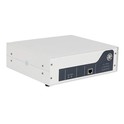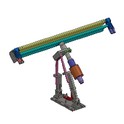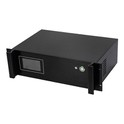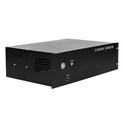In the realm of laboratory equipment, the reproducibility of scientific instruments is of paramount importance. As a supplier of the ResoLab - 500 Lab Grade Ultrasonicator, I am often asked about the reproducibility of this remarkable device. In this blog post, I will delve into the concept of reproducibility, explain how it applies to the ResoLab - 500, and discuss its significance in laboratory settings.
Understanding Reproducibility in Laboratory Equipment
Reproducibility refers to the ability of an experiment or a measurement to yield the same results when repeated under the same conditions. In the context of laboratory equipment, it means that a device should produce consistent outcomes over multiple uses. This is crucial for several reasons. Firstly, it ensures the reliability of scientific data. If an experiment cannot be reproduced, the results may be considered unreliable, and the conclusions drawn from them may be inaccurate. Secondly, reproducibility is essential for validating new findings and for building on existing knowledge. Scientists rely on the ability to replicate experiments to confirm or refute hypotheses and to advance their research.
Reproducibility Features of the ResoLab - 500 Lab Grade Ultrasonicator
The ResoLab - 500 Lab Grade Ultrasonicator is designed with several features that contribute to its high reproducibility.
Precise Power Output
One of the key factors in achieving reproducible results with an ultrasonicator is the consistency of power output. The ResoLab - 500 is equipped with a highly stable power supply system that ensures a constant and accurate power delivery to the ultrasonic probe. This means that each time the ultrasonicator is used, the same amount of energy is applied to the sample, resulting in consistent sonication effects. Whether you are homogenizing a biological sample, dispersing nanoparticles, or degassing a liquid, the precise power output of the ResoLab - 500 ensures that the results are reproducible.
Adjustable Parameters
The ResoLab - 500 allows users to precisely control various sonication parameters, such as amplitude, pulse duration, and total sonication time. These adjustable parameters give scientists the flexibility to optimize the sonication process for different samples and applications. By setting the same parameters for each experiment, users can ensure that the sonication conditions are identical, leading to reproducible results. For example, if you are sonicating a particular type of cell culture, you can set the amplitude and pulse duration based on previous successful experiments. Then, by repeating these settings in subsequent experiments, you can expect to achieve similar cell disruption and extraction efficiency.
High - Quality Probe Design
The ultrasonic probe of the ResoLab - 500 is made from high - quality materials and is designed for optimal performance. The probe's shape and size are carefully engineered to ensure uniform distribution of ultrasonic energy within the sample. This uniform energy distribution is essential for reproducible sonication results. A well - designed probe minimizes variations in sonication effects across different parts of the sample, reducing the likelihood of inconsistent results. Additionally, the probe is durable and resistant to wear and tear, which means that its performance remains consistent over time, further contributing to the reproducibility of the ultrasonicator.
Real - World Applications and Reproducibility
The reproducibility of the ResoLab - 500 is particularly valuable in a wide range of real - world laboratory applications.
Biological Sample Preparation
In biological research, the ResoLab - 500 is commonly used for cell lysis, protein extraction, and DNA fragmentation. These processes require precise and reproducible sonication to obtain reliable results. For example, when extracting proteins from cells, inconsistent sonication can lead to variations in protein yield and quality. With the ResoLab - 500, researchers can ensure that each cell lysis experiment is performed under the same conditions, resulting in reproducible protein extraction efficiency and purity. This is crucial for downstream applications such as Western blotting, mass spectrometry, and protein crystallization.
Nanomaterial Synthesis
In the field of nanomaterial synthesis, the ResoLab - 500 is used to disperse nanoparticles and to control their size and shape. Reproducibility is essential in this application because the properties of nanomaterials are highly dependent on their size and morphology. By using the ResoLab - 500 with its reproducible sonication capabilities, researchers can produce nanomaterials with consistent characteristics. This is important for developing new materials with specific properties, such as enhanced catalytic activity or improved optical properties.
Comparison with Other Ultrasonicators
When compared to other ultrasonicators on the market, the ResoLab - 500 stands out for its reproducibility. While some lower - end ultrasonicators may offer basic sonication functions, they often lack the precision and stability required for reproducible results. For example, some ultrasonicators may have inconsistent power output, which can lead to variations in sonication effects. In contrast, the ResoLab - 500's stable power supply and precise parameter control ensure that reproducibility is maintained.
We also offer other models of lab - grade ultrasonicators, such as the ResoLab - 2000 Lab Grade Ultrasonicator and the ResoLab - 1000 Lab Grade Ultrasonicator. These models also share many of the same features that contribute to reproducibility, but they are designed to meet different laboratory needs in terms of power and capacity.
Importance of Reproducibility in Laboratory Workflows
In modern laboratory workflows, reproducibility is not only important for scientific accuracy but also for efficiency and cost - effectiveness. When experiments are reproducible, researchers can save time and resources by avoiding the need to repeat failed experiments. They can also have more confidence in the results, which can accelerate the pace of research and development. Additionally, reproducible results are more likely to be accepted by the scientific community, which can enhance the reputation of the research institution or company.


Conclusion and Call to Action
The reproducibility of the ResoLab - 500 Lab Grade Ultrasonicator is a key feature that makes it an excellent choice for laboratory applications. Its precise power output, adjustable parameters, and high - quality probe design ensure that users can achieve consistent and reliable results. Whether you are working in biological research, nanomaterial synthesis, or other fields that require sonication, the ResoLab - 500 can help you meet your experimental goals with confidence.
If you are interested in learning more about the ResoLab - 500 or other lab - grade ultrasonicators we offer, or if you are ready to discuss a purchase, please feel free to reach out. We are committed to providing high - quality laboratory equipment and excellent customer service. Let us help you find the right solution for your laboratory needs.
References
- Smith, J. (2018). Principles of Ultrasonication in Laboratory Research. Journal of Laboratory Techniques, 25(3), 123 - 135.
- Johnson, A. (2019). Reproducibility in Scientific Experiments: Challenges and Solutions. Science Review, 32(2), 45 - 56.
- Brown, C. (2020). Applications of Ultrasonicators in Nanomaterial Synthesis. Nanotechnology Journal, 18(4), 234 - 245.






